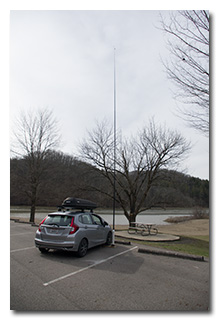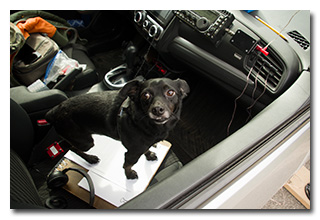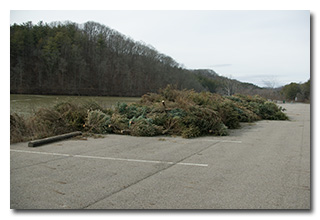
by William Eric McFadden
From the Strouds Run State Park website:
-
Under the proper winter conditions, park guests can enjoy sledding and cross-country skiing.
Pictures
Description
 On Sunday, February 5, 2023, one member of the Southeast Ohio Radio Adventure Team
performed a successful activation of Strouds Run State Park (K-1994) as part of the Parks on the Air
(POTA; link) program.
On Sunday, February 5, 2023, one member of the Southeast Ohio Radio Adventure Team
performed a successful activation of Strouds Run State Park (K-1994) as part of the Parks on the Air
(POTA; link) program.
Having made himself a goal of earning in 2023 the Bear Cave Repeat Offender Activator Award by performing sixty activations of the park, Eric McFadden, WD8RIF, visited the swim-beach area at Strouds Run State Park on an unseasonably warm (55°) but terribly windy morning to perform his 48th activation of the park. He was accompanied by his little dog, Theo.
After driving past the Bulldog Shelter and noticing that the parking lot there was filling up with "Groundhog Hikers", Eric arrived at the swim-beach area at around 1630 UTC and immediately identified a picnic table overhung by a convenient tree to use for his operation. Eric's plan had been to use his Yaesu FT-817ND transceiver with his 28½' wire vertical supported on his 31' Jackite telescoping fiberglass mast leaning into the tree, but two circumstances prevented this from working. First, Eric discovered he had forgotten to pack his LDG 4:1 UNUN and, thus, would unable to connect the 28½' wire vertical to his LDG Z-11 ATU. Second, 30mph wind gusts blew Eric's mast out of the tree not once, but twice, the first fall breaking the wire-radiator's end-insulator. Since he had his Enhanced KX3 Travel Kit with him, Eric decided to use his KX3 inside his car as shelter against the wind, and he deployed his emergency-spare 28½' radiator on the 31' Jackite telescoping fiberglass mast supported on the drive-on base, and he deployed his KX3 inside the car. Eric was on the air at 1649 UTC.
As expected, Eric found he had good cell-signal at this location but was distressed to see that his new smartphone didn't have working internet, so he wouldn't be able to spot himself on the POTA Spots website, or to use POTA Spots to identify possible Park-to-Park (P2P) QSOs. Fortunately, Eric had previously announced his activation on POTA Spots so that auto-spotting should work, and he was able to text his friends K4SWL and K8RAT for spotting-support, if needed.
 Eric began his operation on 20m by selecting a frequency to run and calling "CQ". Eric's first QSO came at
1653 UTC with K7PYP in Idaho. QSOs came very quickly, with Eric's twenty-fifth QSO coming at 1717 UTC
with NA4A in Alabama. Sometime during this run, the wind flexed the Jackite mast enough that the second
section collapsed, but the mast stayed upright, and Eric kept operating. Also during this run, Eric's Whiterook MK-33 keyer paddle
started missing dits and dashes and Eric performed a field-expedient cleaning of the paddle using
a dollar bill. This run included a P2P QSO with N9MM who was activating Sam Houston National Forest
(K-4417) in Texas and QSOs with operators located in Idaho (2), Tennessee (2), South Carolina,
New York (2), California, Washington (2), Texas (5), Illinois (2), New Jersey, Alaska, Kansas,
Oklahoma, Massachusetts, Florida, Pennsylvania, and Alabama.
Eric began his operation on 20m by selecting a frequency to run and calling "CQ". Eric's first QSO came at
1653 UTC with K7PYP in Idaho. QSOs came very quickly, with Eric's twenty-fifth QSO coming at 1717 UTC
with NA4A in Alabama. Sometime during this run, the wind flexed the Jackite mast enough that the second
section collapsed, but the mast stayed upright, and Eric kept operating. Also during this run, Eric's Whiterook MK-33 keyer paddle
started missing dits and dashes and Eric performed a field-expedient cleaning of the paddle using
a dollar bill. This run included a P2P QSO with N9MM who was activating Sam Houston National Forest
(K-4417) in Texas and QSOs with operators located in Idaho (2), Tennessee (2), South Carolina,
New York (2), California, Washington (2), Texas (5), Illinois (2), New Jersey, Alaska, Kansas,
Oklahoma, Massachusetts, Florida, Pennsylvania, and Alabama.
After re-extending his Jackite mast, Eric switched to 40m, found a frequency, and began calling "CQ". Eric's first QSO in this run came at 1721 UTC with K3JAS in Pennsylvania. QSOs came quickly and Eric's eighth QSO in this run came at 1731 UTC with K8RJW in Ohio. Eric's MK-33 paddle continued to work poorly on dits during this run and Eric took a few moments to find his screwdrive and rotate the post which serves as the dit-contact. This seemed to cure the problem of missing dits but Eric needs to test further. This run included QSOs with operators located in Pennsylvania, Michigan, Tennessee (2), Virginia, Wisconsin, Rhode Island, and Ohio.
Switching to 30m, Eric found a frequency and began calling "CQ". His first QSO in this run came at 1736 UTC with K4HPP in Tennessee and his fourth QSO in this run came at 1741 UTC with WS4S in Tennessee. This run included QSOs with operators located in Tennessee (2), Michigan, and Ohio.
In all, Eric made thirty-seven QSOs, including one P2P QSO. All of Eric's QSOs were CW and were made at five watts output.
Eric also submitted his log to the World Wide Flora and Fauna in Amateur Radio (WWFF; link) program for an operation at Strouds Run State Park, KFF-1994.
(return)
